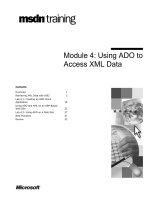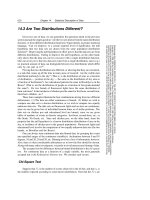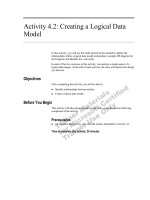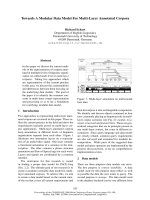4 relational data model section 2
Bạn đang xem bản rút gọn của tài liệu. Xem và tải ngay bản đầy đủ của tài liệu tại đây (2.02 MB, 59 trang )
DATABASE SYSTEMS
RELATIONAL DATA MODEL
Spring 2014
Nguyen Ngoc Thien An
Contents
2
Overview of Relational Data Model
ER- & EER-to-Relational Mapping
Relational Algebra
3
ER- & EER-to-Relational Mapping
Reading Suggestion: [1] Chapter 9
ER- & EER-to-Relational Mapping
4
Step 1: Regular
Entity Types
Step 2: Weak
Entity Types
Step 3: Binary
1:1 Relationship
Types
Step 6:
Multivalued
Attributes
Step 5: Binary
M:N
Relationship
Types
Step 4: Binary
1:N Relationship
Types
Step 7: N-ary
Relationship
Types
Step 8:
Specialization or
Generalization
Step 9: Union
Types
(Categories)
Minit
Fname
SSN
Number_of_employees
N
Lname
Name
Address
1
WORKS_FOR
Name
Locations
Sex
EMPLOYEE
Start_date
Salary
1
Number
DEPARTMENT
1
MANAGES
1
Bdate
CONTROLS
Hours
1
N
SUPERVISION
N
N
N
WORKS_ON
PROJECT
1
Name
DEPENDENTS_OF
Number
N
DEPENDENT
5
Relationship
Name
Sex
Birth_date
Location
ERD of
Company
Database
EMPLOYEE
Fname
Minit
Lname
SSN Bdate Address Sex Salary Super_SSN Dno
DEPARTMENT
Dname Dnumber
Mgr_SSN Mgr_start_date
DEPT_LOCATIONS
Dnumber Dlocation
PROJECT
Pname
Pnumber
Plocation Dnum
WORKS_ON
Essn Pno Hours
DEPENDENT
6
Essn Dependent_name
Sex Bdate Relationship
Relational
Schema of
Company
Database
ER- & EER-to-Relational Mapping
7
Step 1: Regular
Entity Types
Step 2: Weak
Entity Types
Step 3: Binary
1:1 Relationship
Types
Step 6:
Multivalued
Attributes
Step 5: Binary
M:N
Relationship
Types
Step 4: Binary
1:N Relationship
Types
Step 7: N-ary
Relationship
Types
Step 8:
Specialization or
Generalization
Step 9: Union
Types
(Categories)
Step 1: Regular Entity
8
Step 1: Mapping of Regular (Strong) Entity Types
Each regular entity type E Create one new relation S.
Simple attributes of E Attributes of S.
Composite attributes of E Include only their simple component
attributes in S.
Choose one of the key attributes of E as the primary key for S.
The other key attributes of E??? (Homework!!!)
The new relation is called an entity relation.
Each tuple represents an entity instance.
E.g.:
Regular entity types EMPLOYEE, DEPARTMENT, and PROJECT
relations EMPLOYEE, DEPARTMENT, and PROJECT.
Ssn, Dnumber, and Pnumber are the primary keys for the relations
EMPLOYEE, DEPARTMENT, and PROJECT.
Knowledge that Dname of DEPARTMENT and Pname of PROJECT
are secondary keys is kept for possible use later in the design.
Minit
Fname
SSN
Number_of_employees
N
Lname
Name
Address
1
WORKS_FOR
Name
Locations
Sex
EMPLOYEE
Start_date
Salary
1
Number
DEPARTMENT
1
MANAGES
1
Bdate
CONTROLS
Hours
1
N
SUPERVISION
N
N
N
WORKS_ON
PROJECT
1
Name
DEPENDENTS_OF
Number
N
DEPENDENT
9
Relationship
Name
Sex
Birth_date
Location
Step 1:
Regular
Entity
EMPLOYEE
Fname
Minit
Lname
SSN Bdate Address Sex Salary Super_SSN Dno
DEPARTMENT
Dname Dnumber
Mgr_SSN Mgr_start_date
DEPT_LOCATIONS
Dnumber Dlocation
PROJECT
Pname
Pnumber
Plocation Dnum
WORKS_ON
Essn Pno Hours
DEPENDENT
10
Essn Dependent_name
Sex Bdate Relationship
Step 1:
Regular
Entity
ER- & EER-to-Relational Mapping
11
Step 1: Regular
Entity Types
Step 2: Weak
Entity Types
Step 3: Binary
1:1 Relationship
Types
Step 6:
Multivalued
Attributes
Step 5: Binary
M:N
Relationship
Types
Step 4: Binary
1:N Relationship
Types
Step 7: N-ary
Relationship
Types
Step 8:
Specialization or
Generalization
Step 9: Union
Types
(Categories)
Step 2: Weak Entity
12
Step 2: Mapping of Weak Entity Types
Each weak entity type W with owner entity type(s) Ei(s)
Create one new relation S.
Simple attributes and simple components of composite
attributes of W Attributes of S.
The primary key attribute(s) of the relation(s) corresponding to
Ei(s) Foreign key attribute(s) of S.
This takes care of mapping the identifying relationship type of W.
The primary key of S is the combination of the primary
key(s) of the owner(s) and the partial key of W, if any.
E.g.:
Weak entity type DEPENDENT Relation DEPENDENT.
The primary key SSN of EMPLOYEE relation Foreign key
attribute of DEPENDENT (renamed to Essn).
The primary key of DEPENDENT is {Essn, Dependent_name}.
Minit
Fname
SSN
Number_of_employees
N
Lname
Name
Address
1
WORKS_FOR
Name
Sex
EMPLOYEE
Start_date
Salary
1
Number
DEPARTMENT
1
MANAGES
1
Bdate
CONTROLS
Hours
Owner’s
PK
Locations
1
N
SUPERVISION
N
N
N
WORKS_ON
PROJECT
1
Name
DEPENDENTS_OF
Primary
Key
13
Number
N
DEPENDENT
Partial
PK
Relationship
Name
Sex
Birth_date
Location
Step 2:
Weak
Entity
EMPLOYEE
Fname
Minit
Lname
SSN Bdate Address Sex Salary Super_SSN Dno
DEPARTMENT
Dname Dnumber
Mgr_SSN Mgr_start_date
DEPT_LOCATIONS
Dnumber Dlocation
PROJECT
Pname
Pnumber
Plocation Dnum
WORKS_ON
Essn Pno Hours
DEPENDENT
14
Essn Dependent_name
Sex Bdate Relationship
Step 2:
Weak
Entity
ER- & EER-to-Relational Mapping
15
Step 1: Regular
Entity Types
Step 2: Weak
Entity Types
Step 3: Binary
1:1
Relationship
Types
Step 6:
Multivalued
Attributes
Step 5: Binary
M:N
Relationship
Types
Step 4: Binary
1:N Relationship
Types
Step 7: N-ary
Relationship
Types
Step 8:
Specialization or
Generalization
Step 9: Union
Types
(Categories)
Step 3: Binary 1:1 Relationship (1)
16
Step 3: Mapping of Binary 1:1 Relationship Types
R is a relationship type with two entity types E1 and E2.
Case 1: At least one entity type has total participation in R.
E1: the entity type participates totally in R.
Include the primary key of the relation corresponding to E2 as
a foreign key in the relation representing E1.
Include all the simple attributes and simple components of
composite attributes of R in the relation of E1.
E.g.: DEPARTMENT’s participation in the 1:1 relationship type
MANAGES is total.
Include the primary key of EMPLOYEE as foreign key in
DEPARTMENT and rename it Mgr_ssn.
Include the simple attribute Start_date in the DEPARTMENT and
rename it Mgr_start_date.
Step 3: Binary 1:1 Relationship (2)
17
PK1
E1
1
1
R
E1(PK1,…,PK2, A)
Step 3 –
Case 1
PK1
E1
PK2
A
E2(PK2,…)
PK2
A
1
R
E1(PK1,…,PK2,A)
E1(PK1,…)
E2
1
E2
E2(PK2,…)
OR
E2(PK2,…,PK1,A)
Step 3: Binary 1:1 Relationship (3)
18
Case 2: Both entity types have optional participation
in R.
Option 1: the same way in the case 1.
Option 2:
Create a new relation S representing R.
Include the primary keys of the relations representing E1
and E2 as foreign keys in S.
One of them becomes the primary key of S. The other is
a unique key S.
Include all the simple attributes and simple components
of composite attributes of R in S.
The new relation is called a relationship relation.
Each tuple in S represents an instance of R.
Step 3: Binary 1:1 Relationship (4)
19
PK1
PK2
A
1
E1
E1(PK1,…)
R
E2(PK2,…)
1
E2
R(PK1,PK2,A)
OR
E1(PK1,…)
E2(PK2,…)
R(PK1,PK2,A)
Step 3 – Case 2 – Option 2
Step 3: Binary 1:1 Relationship (5)
20
Case 2: Both entity types have optional participation
in R.
Usage:
Option 1:
Drawback: May cause excessive NULL values in the
foreign key.
Usually used when the relation containing the foreign key
has a high percentage of instances participating in R.
Option 2:
Drawback: Having an extra relation, and requiring an
extra join operation when combining related tuples from
the tables.
Usually used when the relations of E1 and E2 have a low
percentage of instances participating in R.
Minit
Fname
SSN
Number_of_employees
N
Lname
Name
Address
1
WORKS_FOR
Name
Locations
Sex
EMPLOYEE
Start_date
Salary
1
Number
DEPARTMENT
1
MANAGES
1
Bdate
CONTROLS
Hours
1
N
SUPERVISION
N
N
N
WORKS_ON
PROJECT
1
Name
DEPENDENTS_OF
Number
N
DEPENDENT
21
Relationship
Name
Sex
Birth_date
Location
Step 3:
Binary 1:1
Relationship
EMPLOYEE
Fname
Minit
Lname
SSN Bdate Address Sex Salary Super_SSN Dno
DEPARTMENT
Dname Dnumber
Mgr_SSN Mgr_start_date
DEPT_LOCATIONS
Dnumber Dlocation
PROJECT
Pname
Pnumber
Plocation Dnum
WORKS_ON
Essn Pno Hours
DEPENDENT
22
Essn Dependent_name
Sex Bdate Relationship
Step 3:
Binary 1:1
Relationship
ER- & EER-to-Relational Mapping
23
Step 1: Regular
Entity Types
Step 2: Weak
Entity Types
Step 3: Binary
1:1 Relationship
Types
Step 6:
Multivalued
Attributes
Step 5: Binary
M:N
Relationship
Types
Step 4: Binary
1:N
Relationship
Types
Step 7: N-ary
Relationship
Types
Step 8:
Specialization or
Generalization
Step 9: Union
Types
(Categories)
Step 4: Binary 1:N Relationship (1)
24
Step 4: Mapping of Binary 1:N Relationship Types
Case 1: The entity type E1 of N-side has total participation
in R.
Case 2: The entity type E1 of N-side has partial
participation in R.
The same way in the case 1 of the step 3.
The same way in the case 2 of the step 3.
Usually use the option 1 when E1 has a high percentage of
instances participating in R.
Otherwise: use the option 2.
E.g.: 1:N relationship types SUPERVISION, CONTROLS,
WORKS_FOR:
WORKS_FOR, CONTROLS: include the primary key Dnumber
of DEPARTMENT as foreign key in EMPLOYEE (called Dno)
and in PROJECT (called Dnum).
SUPERVISION: include the primary key of EMPLOYEE as
foreign key in EMPLOYEE itself (called Super_ssn).
Step 4: Binary 1:N Relationship (2)
25
PK1
E1
PK2
A
N
R
E1(PK1,…,PK2,A)
1
E2
E2(PK2,…)
Step 4 – Case 1









